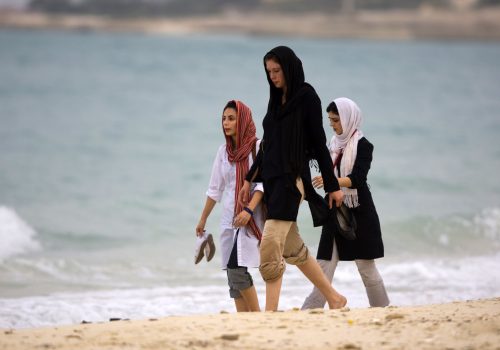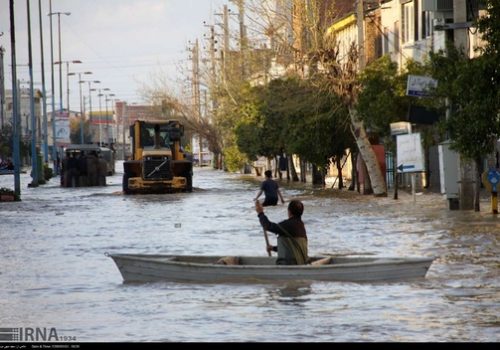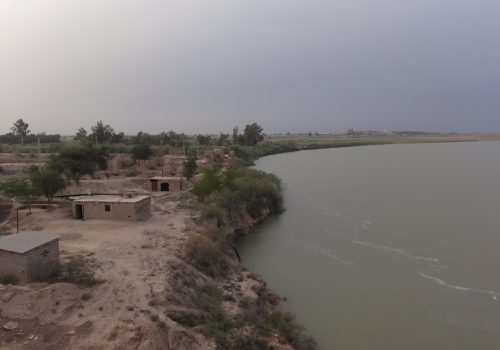The grapes of Khuzestan’s wrath
After decades of poor environmental governance and mismanagement of water resources in Iran’s southwestern Khuzestan province, it’s not surprising that people have taken to the streets once again since July 15, prompting a violent crackdown by security forces and near total internet shutdown. But how did it get to this point?
The historical plain of Khuzestan, which shares a border with Iraq, is often known as “the birthplace of the nation”—one of the oldest human settlements and origin of great ancient civilizations such as the Elamites and Achaemenids.
Yet what has given Khuzestan a special place in modern times has been its oil and gas resources. Eighty percent of Iran’s oil and 60 percent of its gas are in Khuzestan. Therefore, it is natural that Khuzestan and the capital Tehran were at the forefront of the country’s transformation and development in the early twentieth century.
Khuzestan once had the potential to develop agriculturally due to its fertile soil and access to water. For this reason, Khuzestan development was mainly based on agriculture and not just oil. In the 1960s, Mohammad Reza Shah Pahlavi’s government sought to build a Californian plain in the Middle East by recruiting American advisors and setting up modern agro-industrial complexes. The Pahlavi government encouraged the production of new crops such as sugarcane, asparagus, and sugar beet in Khuzestan and set up complementary industries, such as a paper mill, sugar factory, and silk mill to supplement this type of crop. Khuzestan became a promised land to which people migrated from distant provinces for business and opportunities.
However, this golden age in Khuzestan’s history collided with the 1979 Islamic Revolution, leading to the confiscation of factories by the revolutionary forces, expelling of American advisors, and total halt of the industrial development projects during the first two years of the revolutionary regime. In 1981, the eight-year war with Iraq began, effectively destroying much of Khuzestan. After the war, factories were either closed or could no longer compete with foreign competitors under improper management.
The Islamic Republic decided to implement a comprehensive project of self-sufficiency in agricultural production. Based on this decision, they doubled the expansion of agriculture in inaccessible lands, deserts, and even mountain ridges. These projects were very similar to agricultural development plans led by Kim Il Sung in North Korea, Mao Zedong in China, and Hafez al-Assad in Syria. It is conceivable that the clerical establishment, which happened to have and continues to have a very close relationship with these three countries, were influenced by the idea of self-sufficiency in agriculture and how these three countries implemented it.
As a result, the Iranian government pursued complete geoengineering throughout the Iranian landscape and total manipulation of the country’s hydrological system. The statistics in this regard are astonishing. For example, the number of dams increased from less than sixty to more than seven hundred; the number of deep wells increased from less than forty thousand to about one million; and the rate of use of renewable water, which should be a maximum of 40 percent according to the United Nations standard, is reaching nearly 90 percent. In other words, today, 90 percent of water resources are used in 10 percent of the country and 90 percent of Iran’s total land mass has been deliberately deprived of renewable water. As a result, the effects of this severe pressure on ecological capacity gradually showed their results: presently, Iran is among the leading countries in the world in various negative environmental indicators, such as soil erosion, desertification, deforestation, and biodiversity loss.
These man-made problems were also exasperated due to the effects of climate change. Over the past three decades, the average rainfall in Iran gradually decreased by 20 percent less than normal and the average temperature increased by two degrees annually. At first, this situation was called drought. However, drought is a temporary and reversible situation. This situation gradually became permanent, having now caused the shortening of the Karun and Karkheh—two large rivers that enter the Khuzestan plains—to reach almost one-fifth of normal flow.
Now the country is also facing “one of the driest years in five decades.” Iran’s share of the average annual renewable waters decreased from about 130 billion cubic meters to less than one hundred billion cubic meters. Therefore, the situation should no longer be described as drought, but “drying up”—the new destiny of Khuzestan’s lands.
The Khuzestan protests were prompted by the drying up hypothesis: a combination of incorrect geoengineering of the land, unregulated manipulation of the region’s hydrological system, and climate change components, such as reduced rainfall and increased temperature, which have significantly reduced access to water resources. Additionally, the bankruptcy of factories and agro-industrial complexes have practically caused Khuzestan to face the greatest crisis of poverty and unemployment in all provinces of Iran. According to the Statistics Center of Iran, Khuzestan is among the top seven provinces in regard to unemployment.
But the result of this year’s severe drought may be what has sparked the current protests. In spring and winter, the total rainfall was less than half the average amount. This caused the region’s rivers to reach downstream with virtually no water (it’s worth noting that most of the current protests in Khuzestan have occurred downstream of these two rivers south and west of Khuzestan province). The main livelihood of the people of this region is agriculture and animal husbandry, specifically water buffalo that spend hot hours of the day in the river to withstand the scorching heat. When the Karkheh and Karun dried up in fifty degrees Celsius heat in July, it baked the fields, water buffalos died, and the local dust storms intensified due to the drying up of the Hur al-Azim Lagoon, one of the only remaining wetlands in the province. These events only added to land degradation in Khuzestan.
After a July 6 video of an ethnic Arab tribal sheikh and farmers complaining to local authorities went viral, it incentivized people to take to the streets and demand their water rights. The majority of the population in this part of Khuzestan is ethnically Arab and have been historically marginalized, which can turn environmental tension into a driver of ethnic tension as well. However, other ethnic groups in Khuzestan—including the Bakhtiaris and Lurs—have joined the protests, which include slogans such as “Death to the dictator” and “Death to Khamenei.”
How far can the protests in Khuzestan spread and how long will they last? From afar, it may seem that the protests could pose a severe challenge to the Iranian regime. As solidarity protests spread to other cities and towns, including Tehran, the brutal suppressing of protests in December 2017 and January and November 2019—in which thousands were arrested and killed—demonstrates that the Iranian government still has a robust repression machine. Experience also shows that it uses the utmost violence to suppress such protests. Since the demonstrations began, at least eight protesters have been killed by security forces. However, violence won’t change the realities on the ground in Khuzestan: the drying up of land and the loss of livelihood for much of the population.
Dr. Nasser Karami is an Iranian climatologist, geographer, and writer living in Norway. He was previously an associate professor of geography at Azad and Allameh Tabatabai Universities in Tehran, Bergen, and NTNU in Norway. Follow him on Twitter: @nasserkarami.
Image: Water buffalo following herder in Ahwaz, Khuzestan Province, Iran (via PhotoStockEditor)


